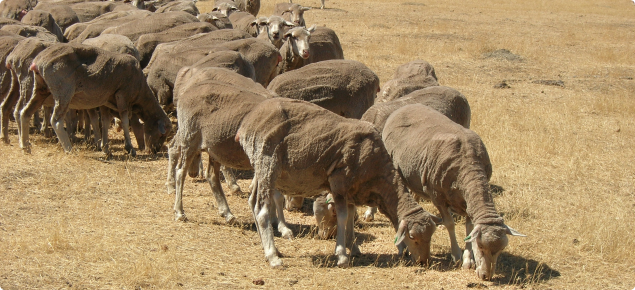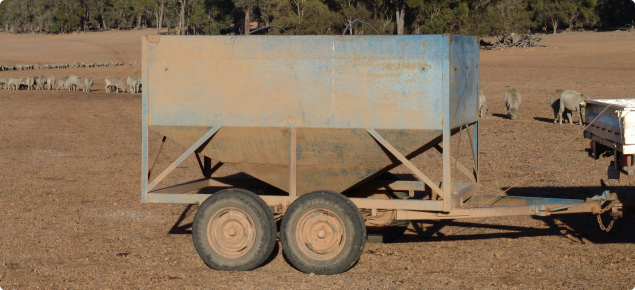Feeding methods
Sheep can be fed in the paddock or in a confined area as a supplement to pastures or stubbles or as a complete ration. Rations are usually in the form of whole grain, hay, pellets or a mix of these feeds.
The grain and roughage portions of a ration can be offered together in a trough, or the grain in troughs or on the ground, and the hay either on the ground, or preferably, in a hayrack.
Trail feeding
If you are going to trail feed, ensure that you have a large enough feed cart. This will ensure savings on labour, fuel and vehicle wear and tear.
It is important to calibrate your feed cart so that you provide an accurate amount of feed to stock when supplementary feeding. The flow rate on feeders will be influenced by the type of grain being fed and to a lesser extent the grain’s bulk density.
A simple way to calibrate your feed cart
- Fill it with the mix of grain required.
- Place a large bucket or tarp under the outlet and let the feed run out freely for a set amount of seconds (we recommend around 15 seconds).
- Weigh the grain that was released and determine the kilograms of grain per second. This will give you a clear picture of the weight of supplementary feed given out when using the feed cart in the paddock.
There have been many instances where sheep have received well under or over their budgeted amount because the feed cart was uncalibrated.
When feed budgeting, or deciding on supplementary feeding rates, it is often necessary to convert the feeding rate (in kilograms or tonnes) to a volume for the feed cart. See Grain weights and volumes, on page 2.
A common concern when feeding lambing ewes, is how to feed them adequately without losing lambs that are left behind and lost when their mothers stampede to the feed trail. In addition, any ewes that are disturbed when they are in the early stages of giving birth may produce dead lambs. Feeding less frequently in a trail is not the answer as the sheep are even hungrier when the feed eventually arrives. There is also a greater risk of acidosis, especially if they are being fed wheat, barley, triticale or peas. Occasionally even lupins or oats, scoffed by hungry sheep, can cause digestive problems.
If trail feeding lupins, a common solution is to scatter enough across the paddock to suffice for a week or two. Sheep are very efficient at finding lupin grain. Some farmers have scattered barley, wheat, oats or peas and this also seems to be successful. Small or cracked grains would probably not be suitable for this form of feeding.
Consider confining lambing ewes to a smaller paddock and run the feed trail so that, when the ewes stampede, no lamb is left more than 100–200 metres away.
Self feeders
Self feeders are a good way to reduce labour when feeding for production. However, they are not a good option when ration feeding (such as during a drought or when maintaining stock). Self feeders are more suited to the finishing of stock where maximum feed intake is required to get sheep to a marketable weight.
Less trough space is required for self feeders. Allow 4–5 centimetres (cm) per lamb and 5–10cm per adult (use the upper end of this allowance for sheep with wool longer than 2cm). Sheep tend to arrange themselves better around circular self feeders than rectangular self feeders.
Lick feeders
Lick feeders feed out in a controlled fashion so you can be confident that the mob will get what they need. Lick feeders attempt to regulate intake of supplement by requiring sheep to actively 'lick' feed from restricted areas within the feeder. Stock become 'tongue tired' and leave the feeder to drink and rest, returning at later intervals to continue the process. Intake can be effectively limited to ensure stock consume as little as a few hundred grams of supplement daily to a full ad lib ration.
There is less wastage with lick feeders from spillage or spoilage (compared with about 20% loss with other types of self feeders) and some claim a 25% reduction in wastage of supplement (compared with trail feeding on the ground).
Some producers have found lick feeders reduce the time and labour required to feed sheep in summer and autumn, as taking out the feed cart can be reduced to once every 5–7 days.
Lick feeders are not labour free. You need to introduce grain slowly, check rates and number per mob, look for blockages, refill feeders and regularly move them around the paddock.
Tips for using lick feeders
- Give lambs access to lick feeder systems prior to weaning to facilitate lamb recognition and use of such systems later in life.
- Use one lick feeder per 200 lambs/sheep in a grazing system (depending on feed availability).
- Use one lick feeder per 110–120 sheep/lambs (maximum) within feedlot or confined feeding area, providing 3.5–4cm trough space/head.
- Trail feed past the face of the feeder to increase lamb awareness of feeders and feed availability.
- Only open up the lick feeder to enable ad lib feeding after careful introduction to the grain used over a 10–14 day period.
- Continue use of feed additives to reduce acidosis.
- Ensure that feed base is partitioned off to:
- reduce the risk of young lambs ‘camping’ in the shade and being left behind by mother
- dominant lambs/sheep using the feeder as a shade source.
Troughs and hay racks
Using appropriate feed troughs can reduce the wastage of grain and the risk of animal health problems (for example, salmonellosis, coccidiosis) when feeding sheep in a confined area. Troughing does not need to be expensive. It is important to have the correct feed space allowance to avoid shy feeding. Allow 10–15cm per lamb or 15–20cm per adult of trough length (use the upper end of this allowance for sheep with wool longer than 2cm). If animals have access to only one side of a trough, the trough length will need to be doubled.
Troughs are best raised off the ground to reduce feed contamination by faeces. However, this may not be practical where a feed trailer has to straddle the trough. Lift the top edge up to 40–45cm for weaners and 50–55cm for adults. Some of the materials that troughing can be made out of include conveyor belt matting, galvanised iron, shade cloth, tarpaulin and commercial channelling.
If feeding hay to sheep, consider purchasing or making some hay racks. Sheep are capable of wasting a large amount of hay when rolls or bales are placed on the ground.
Feeding sheep in confined areas
Feedlots or ‘droughtlots’ require grain feeding. Feedlots do require a bit of extra work but the energy is used efficiently and the rest of the farm is protected from overgrazing.
The main benefits of feedlots are:
- energy saving for sheep, that is, less walking
- less paddock degradation
- good for deferring the grazing at the break of season giving more paddock feed later.
Refer to Confined paddock feeding and feedlotting for details on how to establish an effective feedlot for your sheep.


